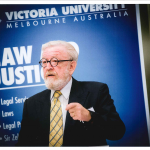It’s Time to Regulate Cocaine and MDMA: An Interview with Transform’s Steve Rolles

The debate around legalising recreational cannabis in this country is growing louder. What once seemed to Middle Australia like a far-out idea held by some rural hippies, nowadays, isn’t such a distant concept as the news of successful legalisation in 10 US states funnels in over the internet.
Currently, there’s a piece of legislation under review in the ACT that aims to legalise the personal possession and use of cannabis in that jurisdiction. It’s expected to pass parliament sometime this year. And it’s based on the model in Vermont: a state that hasn’t established a regulated market.
Most of the US states have implemented some form of regulation, as have Canada and Uruguay. The Canadians ran low on product just days after they legalised the plant last year, while the Uruguayans were the first to legalise it nationally in 2013, although sales didn’t commence there until July 2017.
Legal cannabis could soon become a reality in this state. The NSW Greens have promised to introduce a private member’s bill into parliament within 100 days of the March state election, which would establish a regulated market, and allow for homegrown as well.
The rising trend in regulated pot
Although, the Canadian and Uruguayan cannabis regulation models differ, both nations were informed by a how-to guide published by the Transform Drug Policy Foundation: a UK-based organisation working to reduce drug harms via “evidence-based reforms to policy and practice”.
How to Regulate Cannabis details guidelines on establishing regulated legal cannabis markets for recreational use. The 2013 guide outlines a model focused on public health, moving away from the punitive approach of the war on drugs, which “has conspicuously failed to deliver”.
Transform senior policy analyst Steve Rolles wrote the book in the early years of this decade, which, at the time, was very much a theoretical endeavour. But, now with the tide turning in jurisdictions globally, it’s a guide that can very much be practically applied.
Stimulants on the horizon
Australia’s leading drug law reformer Dr Alex Wodak spoke out in favour of regulating MDMA back in January this year. The doctor made his recommendation at the height of the debate around pill testing during the last music festival season, which saw five young Australians die at NSW events.
The Australian Drug Law Reform Foundation president states that while it can cause harm, MDMA is one of the least dangerous drugs known. And he asserts that if legalised and regulated, the public would hardly ever hear about MDMA “in terms of casualties”.
Steve Rolles is currently writing a book that also recommends that regulated MDMA be made available, along with stimulants in general. And this would mean that Sydney’s favourite drug cocaine, as well as amphetamines, would also be legally available.
Sydney Criminal Lawyers spoke with Mr Rolles about how the regulated cannabis markets around the globe are operating, the model he recommends when it comes to stimulants, and why the ultimate goal is to see all illicit substances legalised and regulated.
Firstly, drug prohibition has been in place for a century now, while the war on drugs has been waged for close to fifty years. Steve, what’s it about the system of prohibition that leads you to recommend turning to a regulated market?
The obvious answer to that question is that the current policy of prohibition has been a manifest failure. The whole pretence of prohibition was to protect the health and well-being of humankind, and it’s demonstrably failed to do that.
The whole assumption of prohibition is that a punitive enforcement approach can meaningfully restrict production and the availability of drugs such that use would be curtailed. And punitive sanctions against users would act as a deterrent to use.
Ultimately, use would be reduced to the point where it would be eradicated. So, we wouldn’t have any production and we wouldn’t have any drug use. And we could all live happily ever after.
But, after 50 years, it’s very clear that almost the exact opposite has happened. Production and availability of drugs has increased. Demand has increased, with illegal production rising in line with it.
It’s really just to do with economics. Where there is a growing demand – which clearly there is with drugs – and there’s no legal supply, you create an opportunity for criminal profiteers. And they’ve seized that opportunity very successfully.
Organised crime is not subject to any formal regulation. They can operate across international boundaries. And they have been very sophisticated and flexible entrepreneurs, who are able to meet the demand for drugs as it has risen over the last two or three generations.
They make what are already risky drugs, even riskier. They are unregulated and their content and potency are unknown. They are often adulterated and mis-sold. They are also sold with no information about risks or harm reduction.
With that, they’ve also brought all kinds of other problems. They create all the problems associated with the illegal trade itself. The violence, the corruption, the insecurity, the fuelling of nonstate actors and displacement of peoples.
These are problems that cross international boundaries: from the streets of western consumers cities, all the way to key production and transit regions, like the jungles of Colombia, the opium fields of Afghanistan and the transit areas of Mexico.
There has been almost unimaginable tragedy and human bloodshed. There have been more than 200,000 drug war-related killings in Mexico over the last decade. These are levels of horror and bloodshed that it’s hard for us to contemplate living our more comfortable lives in the Global North.
It’s those places that are supplying our drugs and they do so relentlessly and very effectively. And despite all the resources we throw at interdiction and eradication. It clearly doesn’t work. And it only seems to be making things worse.
Now, we have issues with heroin – which was a dangerous enough drug anyway – being adulterated with Fentanyl, making it particularly deadly.
So, the drugs are getting more dangerous. The whole business of prohibition has demonstrably failed on its own terms. And we have all these secondary problems associated with the violent criminal trade.
On any meaningful metric, prohibition over the last 50 years has been a catastrophic failure. And on that basis, it’s only right that we should have an adult, evidence-based discussion on alternative approaches that might deliver better outcomes.
The debate around legalising recreational cannabis is growing in Australia. You wrote the ground-breaking 2014 guide How to Regulate Cannabis. It influenced the Canadian and Uruguayan governments when they set up their regulated markets.
How true to what you recommended are the cannabis markets they established? And what would you say have been the impacts of legalising cannabis in those two countries?
The Uruguay model was pretty close to what we recommended. If anything, it was probably more restrictive than what we proposed.
Our model is very much oriented to the interests of public health, rather than the interests of business and profit-making corporations. There’s a real active debate and an important dynamic there, because the interests of public health are often in conflict with the interests of profit-making enterprises.
Profit-making enterprises want to increase their profits, which means increasing consumption. From a public health point of view, that’s not necessarily what you want with drugs. And you only need to look at the experience historically with alcohol and tobacco to see some of the risks there.
Even though, cannabis is certainly not as risky or dangerous to health as alcohol and tobacco, there are clearly risks of it becoming over commercialised and actively promoted as a lifestyle product in the way that alcohol and tobacco have been.
We’ve been very keen to focus on making cannabis – and in the future other drugs – functionally available without actively promoting them in the way that we’ve seen with alcohol and tobacco.
We were very pleased to see what happened in Uruguay, where it was a more strictly regulated market. There are particular regulations on branding, advertising and retail availability.
We were also pleased to see that they kept open the option for small-scale home growing for personal use and small-scale cannabis social club models, so that people could grow and share amongst themselves on a non-profit cooperative basis.
The Uruguay model was perhaps too restrictive in requiring people who wanted to buy state-controlled cannabis from pharmacies to register. But, to be fair, that was probably a reflection of the political climate.
They were the first country to do it. They erred on the side of caution and went for a very restrictive model, which was maybe too restrictive on reflection. But, on the whole, it has been a good model.
It’s very new, so it’s hard to make too many comments about precisely how successful it is. As we don’t have too much data yet, because the shops have only been open for just over a year. But, on the whole, it does seem to be delivering on most of the key elements.
One of the things that they did was to put in place a very effective monitoring and evaluation system. And they also agreed that they needed to be flexible, so if things weren’t working, they could revisit them.
And that’s the basis of a rational, evidence-based policy: you do something with the best intentions, and you evaluate it. If it’s not working, you’re able to take a step back and loosen the system up a bit if it seems overly restrictive.
Canada also followed the general approach that was proposed by Transform. They set up a federal taskforce of experts, which is where Transform fed in.
They agreed with most of the general principles that we were proposing: that it was guided by public health, there would be strict controls on branding and advertising, to generally go for state-controlled retail premises, and price and tax controls appropriate for the risks of cannabis.
If there are any problems with the Canadian system, it is that there were already some quite large-scale corporate cannabis interests in the country.
There is a concern that some of these companies – like Aurora and Tilray, which are now worth billions – will have an undue influence on the policy development process. They may skew the process towards corporate interest more than public health.
Generally-speaking, Canada has got a pretty good grip on their cannabis market. And the regulations are generally good and appropriate. But, there are some problems with it. Some of the penalties are excessive. And some of the preparations for the launch date were inadequate.
But, Canada has a different challenge to Uruguay in that each province has their own cannabis policy. The federal government is in charge of production, taxation and transport, whereas the provinces are in charge of retail.
So, you have 13 provinces and territories and 13 different models in Canada. And we don’t really have any data either, as they’ve only been open for less than a year.
And again, they have a good monitoring system, and the systems are flexible enough to respond to some of the challenges that might emerge in this initial period. On the whole, they’ve done a good job.
The other comparison is the American state models that Transform weren’t involved with. They were ballot initiatives, so they were more activist and industry driven. And that’s reflected in their more commercialised nature.
Interestingly, what we have now is these different models across the Americas. More commercialised models in the US. A state-controlled model in Uruguay. And Canada sitting somewhere in between.
We can look at the outcomes over the coming months and years. We can see how they do, and where the problems are. Other countries can look at this kind of natural experiment and learn from the data. And obviously, Australia is one of those countries.
Currently, you’re working on the world’s first guide to regulating stimulants. Over here, there’s been talk about regulating MDMA of late. Your book will also cover cocaine and amphetamines.
How do you suggest these drugs be sold? What sort of regulations would be put in place around their availability?
Obviously, stimulants is a very broad term and can mean lots of different things. The risks associated with taking MDMA pills in a nightclub are very different from the risks of smoking methamphetamine or crack or injecting cocaine.
We need to have different responses for different drugs that are associated with different risks. And also, for the different behaviours that people engage with and the different environments in which they take those drugs.
It’s not a single model. But, generally-speaking, for pharmaceutical stimulants we’re advocating an adults-only, rationed pharmacy – or pharmacy equivalent – sales model, where adults can buy some of these drugs for personal use, whether that be MDMA or cocaine.
There are two key elements to the model we’re proposing. One is that we would have a licenced buyer model. So, in the same way you have to get a licence to buy a car, you would have to get a drug buyer licence to access these specific drug markets.
What that would involve is that you would have to go to an education course for a few hours that would explain what these drugs were, their effects, their risks and how to spot danger signs.
It would be a risk education course. And once you’ve done that you would have access to the market on a rationed basis. So, it could be, for example, two ecstasy pills a month or one gram of cocaine a week. Whatever was determined to be a reasonable amount of a given drug over a period of time.
Deciding on the specifics of those quantities is an open question for different drugs. But, basically, you’d have a rationed licenced buyer system.
A second key element is you would access the drugs via a pharmacy-like model.
It might not be an actual pharmacy, but it would be similar to one, where the pharmacist or druggist would be a trained and licenced individual, who not only has to enforce the code of conduct – as in not serving those who are intoxicated – but they would also be trained to give advice on safer use.
In the same way a pharmacist gives you advice on over-the-counter drugs or prescription drugs, the druggist would be able to give you similar qualified medical advice, as well as actually doing the retailing.
Some people may regard that as a restrictive system and wonder why they can’t just buy the drugs in shops in the same way that they do alcohol and tobacco. And it may well be that it is. But, we have to start somewhere.
And a cautious start is prudent, because we don’t know how the market would develop if it was more open or commercialised. We don’t want to see these things openly promoted. We don’t want to see cocaine and ecstasy brands sponsoring music events or sports teams.
These would be non-branded, pharmaceutical products sold by an actual pharmacist – or someone very similar – on a licenced adult user rationed basis. At least, as a starting point.
Over the last decade, there’s been a lot of talk in this country about a methamphetamine crisis. There’s been a lot of sensational media about it. And I’ve spoken to people who advocate for drug decriminalisation, but they simply draw the line at this one.
But, you propose that it too be regulated. In your opinion, how should methamphetamine be legally available?
We’re talking about a range of using behaviours associated with a range of risks. A public health approach has to identify risk behaviours and vulnerabilities, and target them.
Regarding people who are smoking methamphetamine daily, or injecting it regularly, we’re talking about problematic or dependent patterns of use. And they need a medical response. What that response should be is up to clinicians. It’s important that you would have a range of treatments available.
These would include harm reduction responses as part of the menu of options. These harm reduction options could involve the prescribing of methamphetamine – not necessarily in smokable or injectable forms – but in slow-released pill form, which is a less risky preparation.
Methamphetamine is a licenced drug and it can be prescribed. There’s some literature on how to do that for people who are dependent on it.
But, it’s also important to look at the bigger picture, which is that prohibition has tended to push the market for all drugs – not just stimulants – towards the most profitable products, which also tend to be the most potent and dangerous preparations.
You can get heroin on the streets in most cities around the world. But, it’s very difficult to get smokable opium, which is much safer. Similarly, methamphetamine is the most potent and risky form of amphetamines. But, other less risky forms aren’t so easily available.
One thing that we would like to do with stimulant regulation is to create a risk availability gradient, where the riskier products, like smokable methamphetamine, were less available, perhaps only available under a very restrictive medical prescription model.
The less risky, oral slow-release amphetamine products would be more easily available. And in doing that, rather than push the market towards the riskier product, we could gradually tilt it in the other direction towards safer products and using behaviours.
That’s one of the approaches. But, also, in responding to methamphetamine use, if you could prescribe less risky products, like slow-release, oral dexamphetamine pills, it may well be that people would shift from the riskier drug to the less risky one.
In that context, we have to look at stimulants as a whole, and not just focus on an individual one. Methamphetamine has never caught on in the UK, because there was a ready availability of dexamphetamine and amphetamine sulphate.
So, there was never a demand for the more potent product, because the less potent products were where demand settled.
If people seek the effect of methamphetamine, we need to use our regulated system to encourage people to move towards the safer, lower potency products and the safer methods of administration: oral, rather than smoked or injected.
It would meet their needs, but in a safer way.
And lastly, Steve, you’ve written the book on cannabis regulation. And you’re writing the book on stimulants. What about other drugs, such as opioids and psychedelics? Should all illicit drugs be legalised and regulated?
Transform wrote a book in 2009 called After the War on Drugs: Blueprint for Regulation. It looks at regulation theory in general, in terms of products, vendors, production, marketing and user controls. It has chapters for stimulants, opioids, cannabis and psychedelics, which consider the optimal models for each.
In Blueprint, we did talk about cocaine and MDMA regulation. We just felt the time had come to provide a bit more detail: to flesh out these models, so that people have something to grasp, as these debates move forward beyond cannabis.
The cannabis debate has its own momentum now. It’s no longer just a theoretical debate, as there are multiple jurisdictions around the world that are actively developing, implementing or have already implemented cannabis regulation.
It’s time for the debate to move onto other drugs, because even though they may be riskier than cannabis, the same logic applies. However, risky a drug is, it’s always going to be riskier when you abdicate responsibility for its production and supply to profit-motivated criminal entrepreneurs.
For any drug, however risky it is, legal regulation is a pragmatic position. It’s not an endorsement of the drug. It’s an acceptance that the market exists. And it acknowledges the need to deal with that reality.
Rather than pursue the fantasy that we can create a drug-free world, we need to deal with the reality of drugs. It’s either government or gangsters regulating them. There’s no third option, in which the market magically disappears.
So, we need to make a pragmatic choice and regulate these things, because drugs are here like it or not.
This is one of the problems we have when you talk about regulation. People sometimes say you’re endorsing or condoning the use of those drugs – or you are somehow pro-drugs. And it really isn’t that. We’re just being pragmatic.
There are 250 million people around the world using illegal drugs. The market is worth $300 billion a year. It’s time to deal with that reality, and regulate it in ways that reduce harm, just as prohibition has demonstrably done the opposite.
And that applies to all drugs, not just cannabis.







